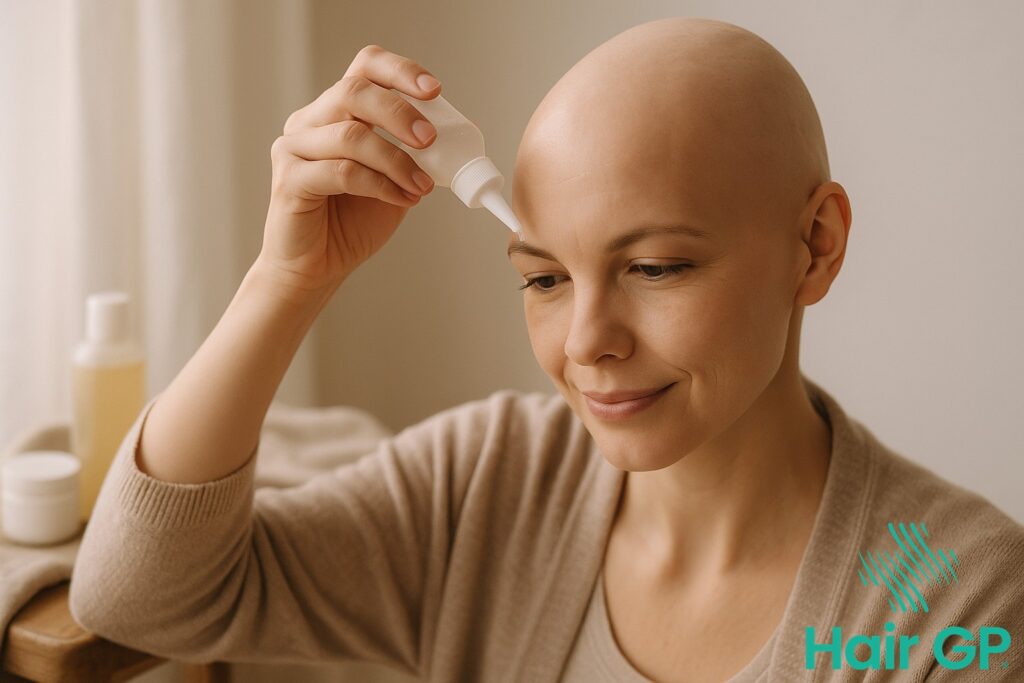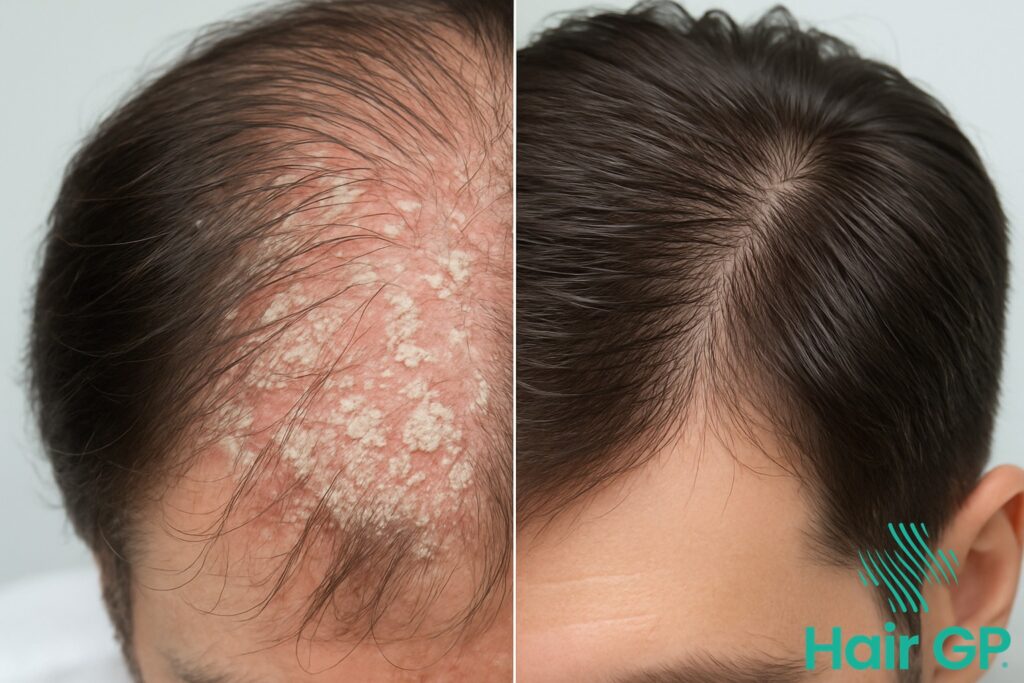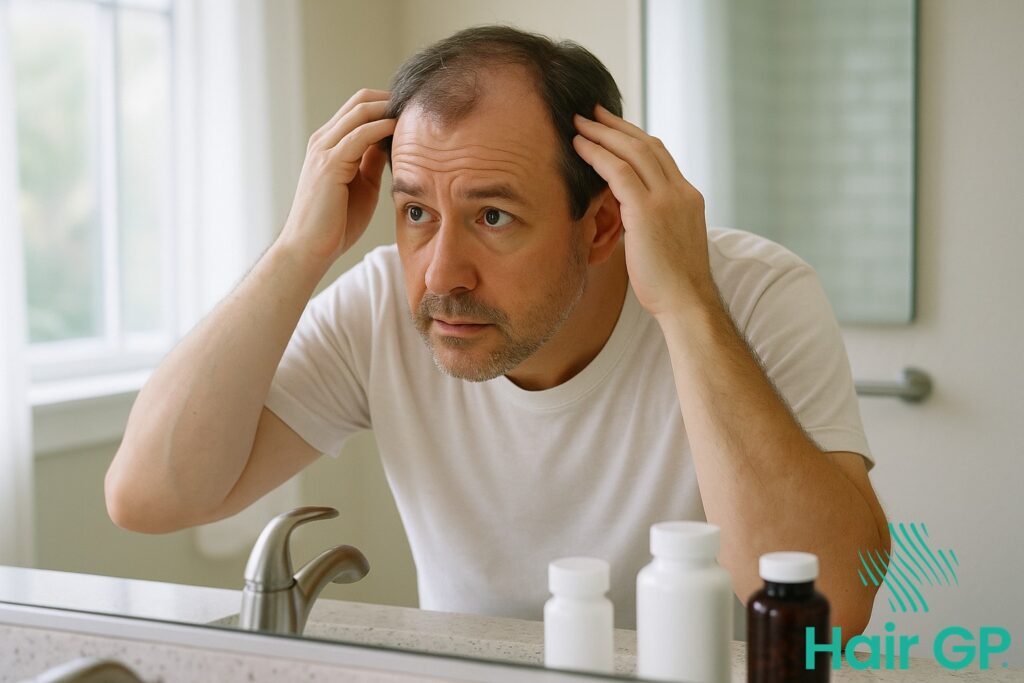Introduction
For many cancer patients undergoing chemotherapy treatment, scalp sensitivity represents one of the most challenging and uncomfortable side effects to manage. This common yet often overlooked concern can manifest as tenderness, itching, burning sensations, or extreme sensitivity to touch, temperature, and even air movement. Understanding and addressing these symptoms with proper care can significantly improve comfort and quality of life during treatment.
Chemotherapy patients experience scalp sensitivity because powerful cancer-fighting drugs affect rapidly dividing cells, including those in hair follicles and surrounding scalp tissue. This disruption can occur before, during, and after hair loss, creating unique care challenges at each stage. The good news is that with the right knowledge and gentle approaches, you can effectively manage your sensitive scalp throughout your treatment journey.
This comprehensive guide explores evidence-based strategies for caring for your scalp during and after chemotherapy. You’ll discover how to establish soothing daily routines, select appropriate fabrics and products, and utilise both natural remedies and medical interventions for relief. We’ll examine innovative approaches like scalp cooling technology, nutritional support for healing, and practical solutions for specific symptoms you may encounter.
Beyond physical care, we recognise the emotional impact of scalp changes and hair loss. This guide addresses the whole person, offering strategies for emotional wellbeing alongside practical care techniques. Whether you’re just beginning treatment or supporting your scalp through regrowth, you’ll find gentle, effective solutions tailored to your needs.
Key Takeaways – TL/DR
- Scalp sensitivity affects up to 65% of chemotherapy patients and requires specialized care approaches
- Natural fabrics like bamboo, silk, and organic cotton provide optimal comfort for sensitive scalps
- A combination of gentle cleansing, moisturizing, and scalp cooling can significantly reduce discomfort
- Most scalp sensitivity resolves within 3-6 months after completing chemotherapy
- Professional guidance from oncology nurses can help personalize scalp care routines
Understanding Scalp Sensitivity During and After Chemotherapy
Chemotherapy-induced scalp sensitivity affects a significant proportion of cancer patients, with research indicating that up to 65% experience some degree of scalp discomfort during treatment[1]. This sensitivity occurs because chemotherapy drugs target rapidly dividing cells throughout the body, including those in hair follicles and surrounding scalp tissue, leading to inflammation and nerve irritation that can persist throughout treatment cycles.
How Chemotherapy Affects Your Scalp
Chemotherapy drugs work by disrupting cell division in rapidly multiplying cells, which unfortunately includes healthy cells in hair follicles and scalp tissue[2]. When these medications enter the bloodstream during chemotherapy sessions, they cannot distinguish between cancer cells and the fast-growing cells in your scalp. This process triggers an inflammatory response in the scalp tissue, causing blood vessels to dilate and immune cells to flood the area.
The inflammation leads to increased nerve sensitivity, making previously normal sensations feel uncomfortable or painful. Additionally, as hair follicles become damaged, they release inflammatory mediators that further sensitise surrounding nerve endings. This biological cascade explains why many cancer patients report that even gentle touches or temperature changes can cause significant discomfort during treatment.
Common Symptoms and Timeline
Scalp sensitivity typically begins within the first few days after initial chemotherapy treatment, often presenting as mild tingling sensations that gradually intensify. Many patients describe the feeling as similar to having a severe sunburn on their scalp, with burning feelings that worsen when touching or moving their hair. The sensitivity usually peaks between days 3-7 after each treatment cycle.
As treatment progresses, symptoms may evolve from tingling to more pronounced burning or stabbing sensations. Some patients experience intense itching, whilst others report feeling as though their scalp is constantly tight or under pressure. These symptoms generally begin to subside 2-3 weeks after completing chemotherapy, though complete resolution may take several months.
Risk Factors for Increased Sensitivity
Several factors can intensify scalp sensitivity during cancer treatment. Patients with low platelet counts often experience more severe symptoms due to increased bleeding tendency and slower healing in scalp tissue. Those undergoing combination therapies, particularly when chemotherapy is paired with radiation therapy to the head or neck region, typically report heightened sensitivity levels.
Pre-existing conditions such as eczema, psoriasis, or general skin sensitivity can predispose patients to more severe scalp reactions. Additionally, certain chemotherapy drug combinations are associated with increased scalp sensitivity, though individual responses vary significantly. Understanding these risk factors helps healthcare providers anticipate and manage symptoms more effectively throughout treatment.
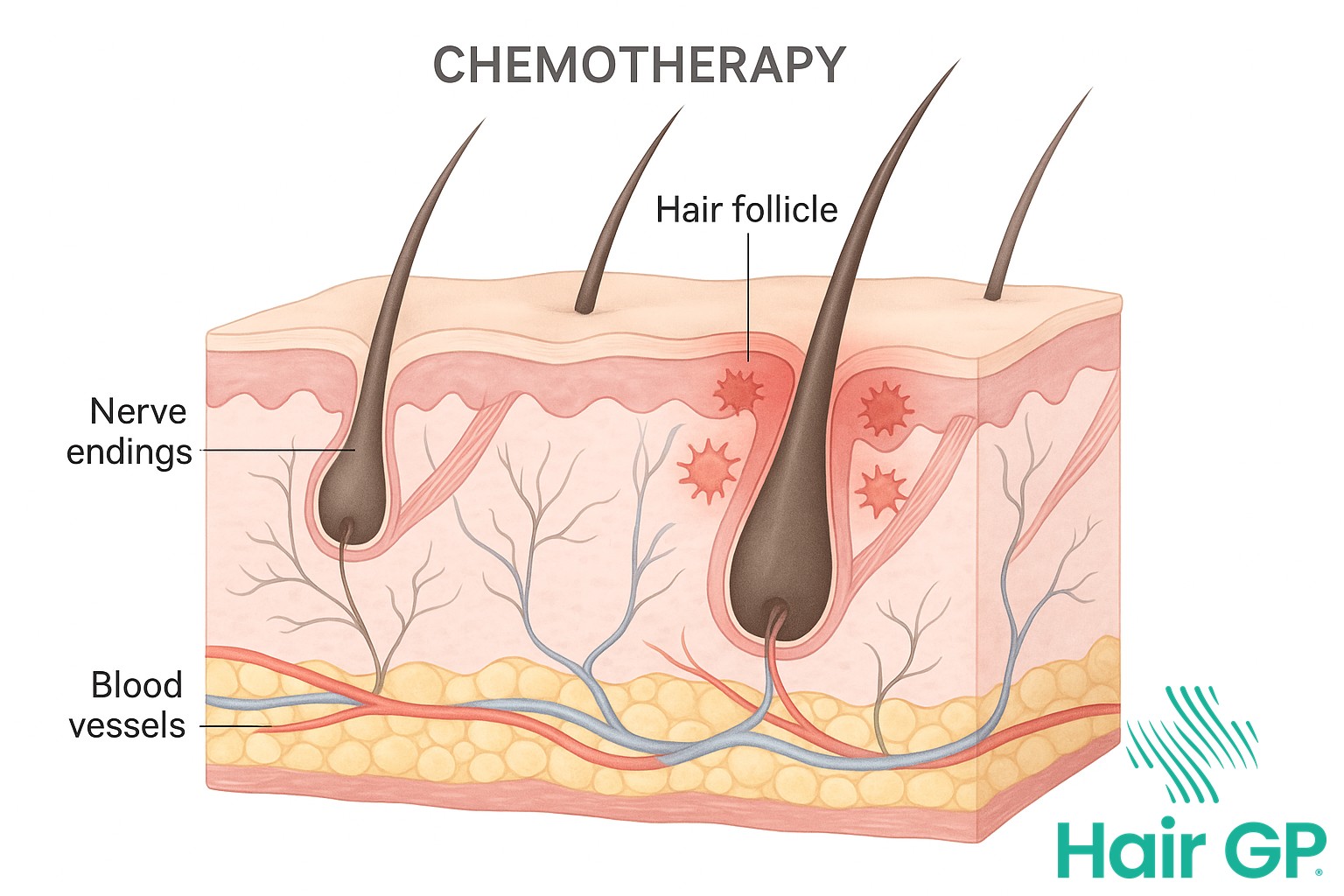
Immediate Post-Chemo Scalp Care Essentials
The initial 48-72 hours following chemotherapy treatment represent a crucial window for establishing protective scalp care routines. During this period, your sensitive scalp requires specialised attention to minimise discomfort and prevent complications. These evidence-based practices will help you navigate the immediate post-treatment phase with confidence and comfort.
The First 48 Hours: Critical Care Window
Immediately after chemotherapy, your scalp enters its most vulnerable state, requiring careful temperature management and protection. Keep your environment cool and comfortable, as heat can intensify sensitivity and discomfort for chemotherapy patients. Maintain room temperatures between 18-20°C and use fans rather than direct air conditioning, which can cause excessive dryness.
Hydration plays a vital role in maintaining scalp health during this critical period. Drink at least 2-3 litres of water daily to support your body’s natural healing processes and maintain skin moisture from within. Avoid common irritants such as perfumed products, hair sprays, and styling tools. Even seemingly harmless items like scented tissues or pillowcases can trigger reactions on your sensitive scalp during this time.
Gentle Cleansing Techniques
When washing your scalp, temperature control is paramount. Use lukewarm water, testing it on your wrist first to ensure it feels comfortable. Hot water can strip natural oils and increase sensitivity, whilst cold water may cause uncomfortable sensations. Choose a mild shampoo specifically formulated for sensitive scalps, applying it with minimal pressure.
Instead of rubbing, use your fingertips to create gentle circular motions across your scalp. This technique cleanses effectively without causing irritation or disrupting healing skin. Limit washing to 2-3 times weekly unless otherwise advised by your healthcare team. After cleansing, pat your scalp dry with a soft, clean towel—never rub vigorously. Allow your scalp to air dry when possible, as heat from hairdryers can exacerbate sensitivity.
Protective Measures During Sleep
Nighttime presents unique challenges for scalp care, as friction and temperature fluctuations can disturb healing skin. Silk or satin pillowcases offer significant benefits, reducing friction and helping maintain moisture levels throughout the night. These smooth fabrics allow your head to glide across the surface without catching or pulling on delicate skin.
Sleep on your back when possible to minimise pressure on any particularly sensitive areas. If side-sleeping is necessary, alternate sides to prevent prolonged pressure on one area. Keep your bedroom cool and well-ventilated, using breathable bedding materials. Consider placing a small fan nearby for gentle air circulation without direct exposure.
When to Contact Your Healthcare Team
Whilst some discomfort is expected, certain symptoms require immediate medical attention. Contact your healthcare team if you experience severe, persistent pain that doesn’t respond to prescribed pain relief, or if you notice signs of infection such as increased redness, swelling, or discharge[1]. Fever above 38°C, spreading rash, or blistering also warrant urgent consultation[2].
Document any unusual reactions or persistent symptoms in a diary, noting their onset and progression. This information helps your medical team adjust your scalp treatments and overall care plan effectively. Never hesitate to seek guidance—early intervention often prevents minor issues from becoming serious complications.
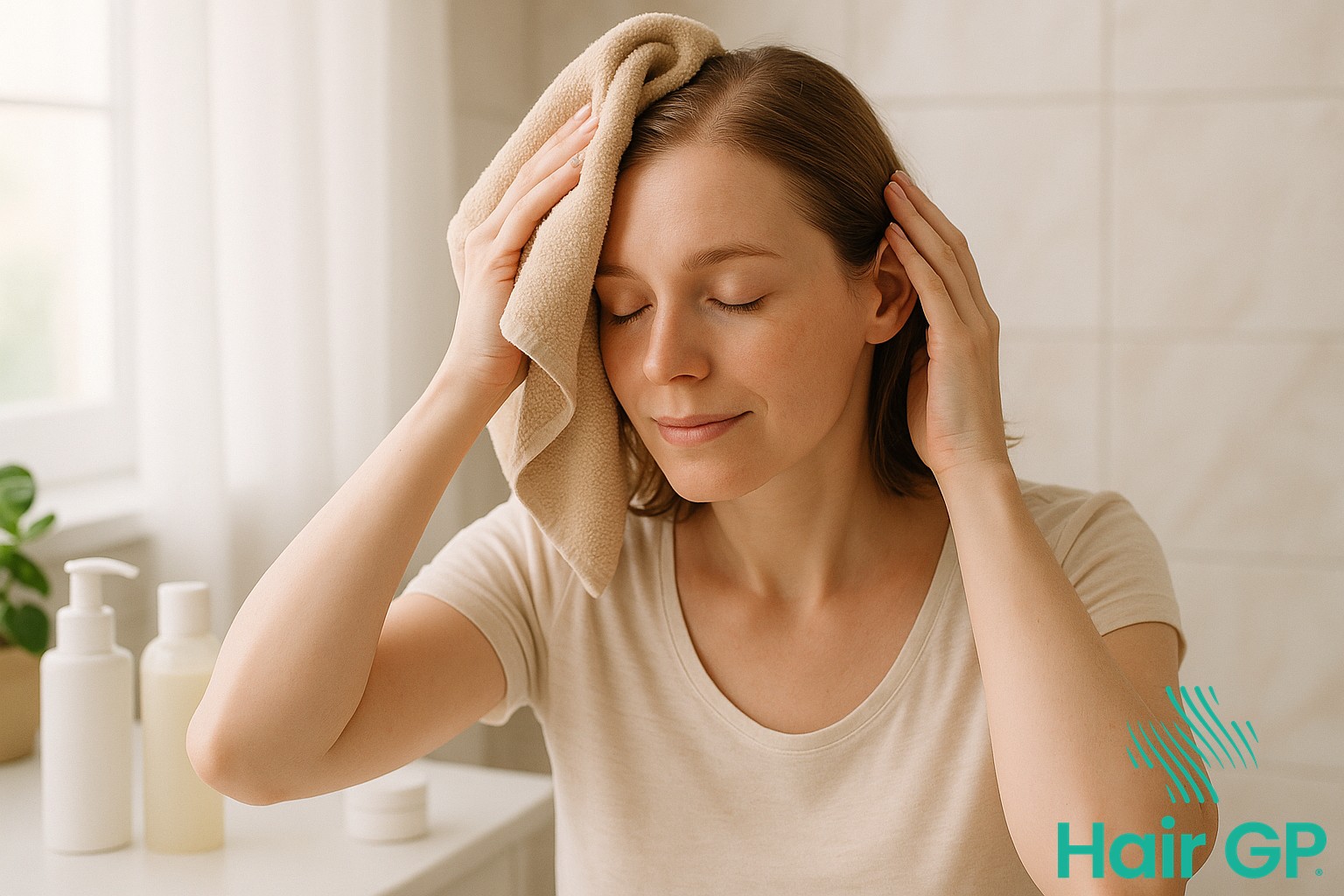
Choosing the Right Fabrics for Sensitive Scalps
Selecting appropriate fabrics for chemotherapy-sensitive scalps requires careful consideration of material properties and comfort factors. The right fabric choice can significantly reduce irritation whilst maximising comfort for cancer patients experiencing heightened scalp sensitivity. Understanding which materials work best and how to care for them ensures optimal relief during treatment.
Natural Fibre Champions
Bamboo fabric emerges as an exceptional choice for sensitive skin, offering natural antibacterial properties and exceptional softness. Its moisture-wicking capabilities help regulate temperature whilst the smooth fibres minimise friction against delicate scalp tissue. The hypoallergenic nature of bamboo makes it particularly suitable for those experiencing chemotherapy-related sensitivities.
Organic cotton provides reliable comfort through its breathability and chemical-free processing. Unlike conventional cotton, organic varieties undergo gentle manufacturing processes that preserve the fabric’s natural softness. This material allows proper air circulation whilst absorbing moisture effectively, preventing the damp conditions that can exacerbate scalp discomfort.
Silk stands out for its remarkably smooth texture and temperature-regulating properties. A silk pillowcase can dramatically reduce friction during sleep, preventing additional irritation to already sensitive scalps. The protein structure of silk closely resembles human hair, making it particularly gentle on exposed skin whilst providing luxurious comfort during rest.
Fabric Features to Look For
Breathability remains paramount when selecting fabrics for sensitive scalps. Materials that allow proper air circulation help prevent overheating and moisture build-up, both of which can intensify discomfort. Look for open-weave constructions or naturally breathable fibres that promote continuous airflow.
Moisture-wicking properties prove essential for maintaining scalp comfort throughout the day. Fabrics that effectively draw moisture away from the skin help prevent irritation caused by perspiration. This feature becomes particularly important for cancer patients experiencing hot flushes or increased sweating during treatment.
Hypoallergenic properties ensure minimal risk of allergic reactions or additional irritation. Seek fabrics specifically labelled as hypoallergenic, avoiding those treated with harsh chemicals or dyes that might trigger sensitivity reactions on already compromised skin.
Head Covering Options and Materials
Scarves offer versatile coverage options, with lightweight silk or bamboo scarves providing gentle protection without excessive weight. These materials drape beautifully whilst allowing scalp breathability, making them ideal for both indoor and outdoor wear.
Caps designed specifically for sensitive scalps often feature seamless construction and ultra-soft materials. Look for options made from bamboo-cotton blends or modal fabric that provide full coverage whilst maintaining comfort throughout extended wear.
Turbans crafted from stretchy, gentle materials offer secure coverage without requiring tight tying or adjustment. Pre-formed turbans eliminate pressure points whilst providing fashionable coverage options.
For those seeking wig alternatives, lightweight fabric caps with attached hair pieces offer the appearance of hair without the weight and heat retention of traditional wigs.
Caring for Your Gentle Fabrics
Proper washing maintains fabric softness and extends garment life. Use fragrance-free, gentle detergents in cool water, avoiding fabric softeners that can leave irritating residues. Hand washing proves ideal for delicate items.
Air drying preserves fabric integrity better than machine drying. Lay items flat or hang in shade to prevent sun damage that can roughen fibres. If machine drying becomes necessary, use the lowest heat setting.
Store head coverings in breathable cotton bags rather than plastic, allowing fabrics to maintain freshness between uses. Regular rotation of items ensures even wear whilst maintaining optimal hygiene.
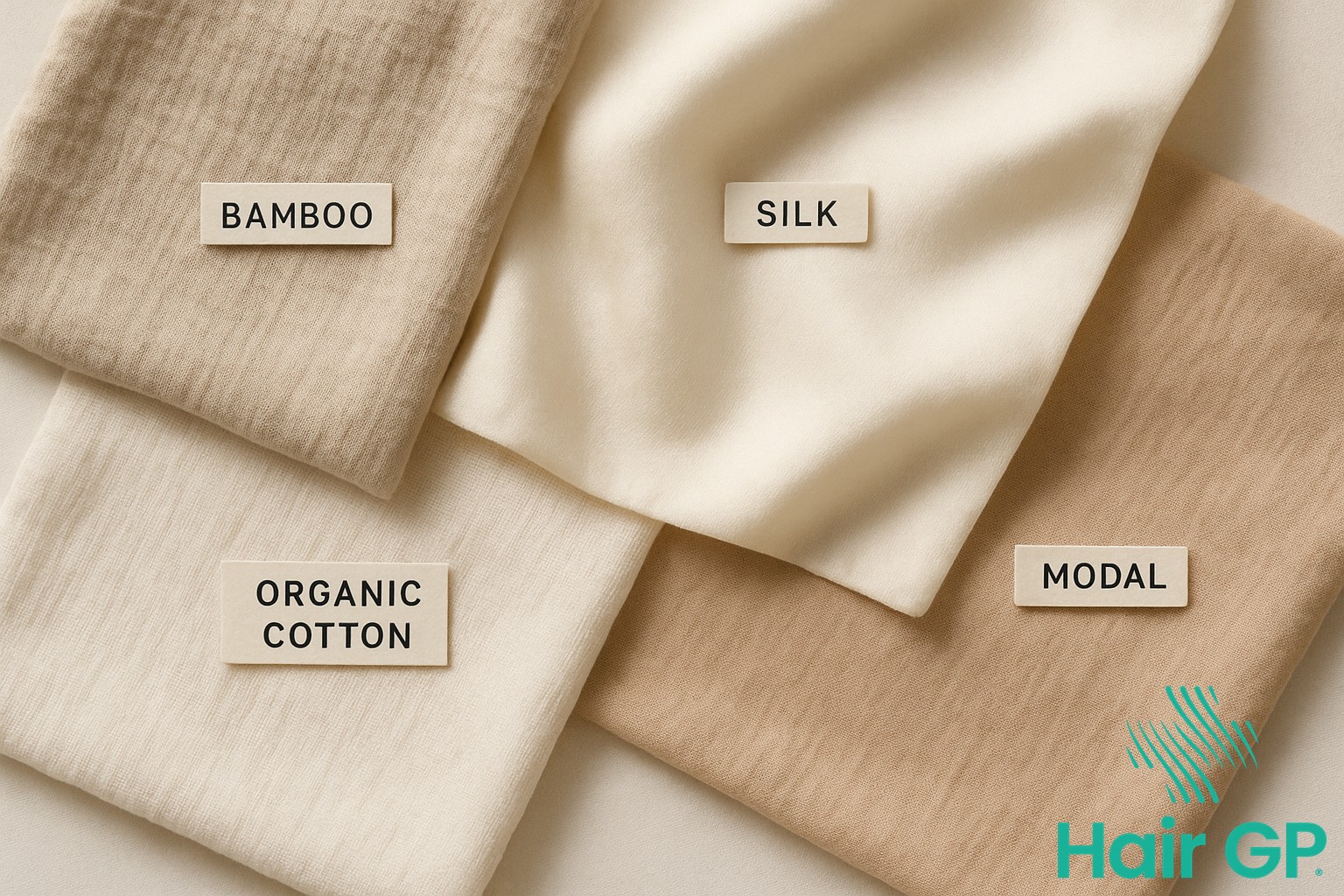
Daily Scalp Care Routine for Maximum Comfort
Establishing a comprehensive daily care routine forms the foundation of maintaining scalp health during chemotherapy recovery. This structured approach addresses cleansing, moisturising, and protective measures throughout the day, ensuring your scalp remains comfortable whilst adapting to its changing needs. Regular scalp care promotes healing, prevents complications, and enhances overall wellbeing during treatment.
Morning Scalp Care Ritual
Begin your morning routine by gently awakening your scalp with light touches, assessing overnight changes or sensitivities. If cleansing is needed, use lukewarm water and a fragrance-free, pH-balanced cleanser specifically formulated for sensitive scalps. Pat hair gently with a soft microfibre towel, avoiding rubbing motions that might irritate delicate skin.
Apply a lightweight, non-comedogenic moisturiser using gentle circular motions to promote absorption. Choose products containing ceramides or hyaluronic acid for optimal hydration without heaviness. Complete your morning routine with broad-spectrum SPF 30+ sunscreen, even on cloudy days, as chemotherapy increases photosensitivity. Reapply sun protection before any outdoor activities.
Midday Comfort Checks
Throughout the day, perform quick assessments to maintain scalp comfort. Check for temperature changes—remove hats or scarves if your scalp feels too warm, as excessive heat can increase irritation. Monitor moisture levels by lightly touching different areas of your scalp; if dryness develops, apply a hydrating mist or light moisturiser.
Adjust head coverings to prevent pressure points or friction. Switch positions of clips or bands, and ensure fabrics remain clean and breathable. Keep a small kit with essential items like moisturiser, soft tissues, and a travel-sized sunscreen for on-the-go adjustments.
Evening Wind-Down Routine
Evening scalp care focuses on cleansing away daily accumulation whilst preparing for restorative sleep. Use gentle, downward strokes when cleansing to avoid disrupting the scalp’s natural protective barrier. Rinse thoroughly with cool water to close pores and reduce inflammation.
Apply nourishing treatments containing ingredients like aloe vera or chamomile extract, which provide overnight healing benefits. Consider using a silk or satin pillowcase to minimise friction during sleep. Ensure your sleeping environment maintains comfortable humidity levels, using a humidifier if necessary to prevent overnight dryness.
Adapting Your Routine to Scalp Changes
Flexibility in your daily care routine ensures optimal scalp health as conditions fluctuate. For dry scalps, increase moisturising frequency and switch to richer formulations containing natural oils like jojoba or argan. Reduce cleansing to every other day, using co-washing techniques when possible.
Oily scalps benefit from more frequent, gentle cleansing with clarifying products. Incorporate clay-based treatments weekly to balance sebum production. Adjust product quantities based on sensitivity levels—highly sensitive scalps require minimal product application and extra-gentle techniques throughout all care steps.
Scalp Massage Techniques
Incorporate scalp stimulation through gentle massage techniques that enhance circulation without causing irritation. Using fingertip pads, apply light pressure in small circular motions, starting from the hairline and working backwards. Focus on pressure points at the temples, crown, and base of the skull for maximum relaxation benefits.
Limit massage sessions to 3-5 minutes twice daily, adjusting pressure based on comfort levels. Avoid massage during periods of extreme sensitivity or active treatment days. These techniques promote healthy scalp circulation, reduce tension, and provide psychological comfort during challenging treatment periods.
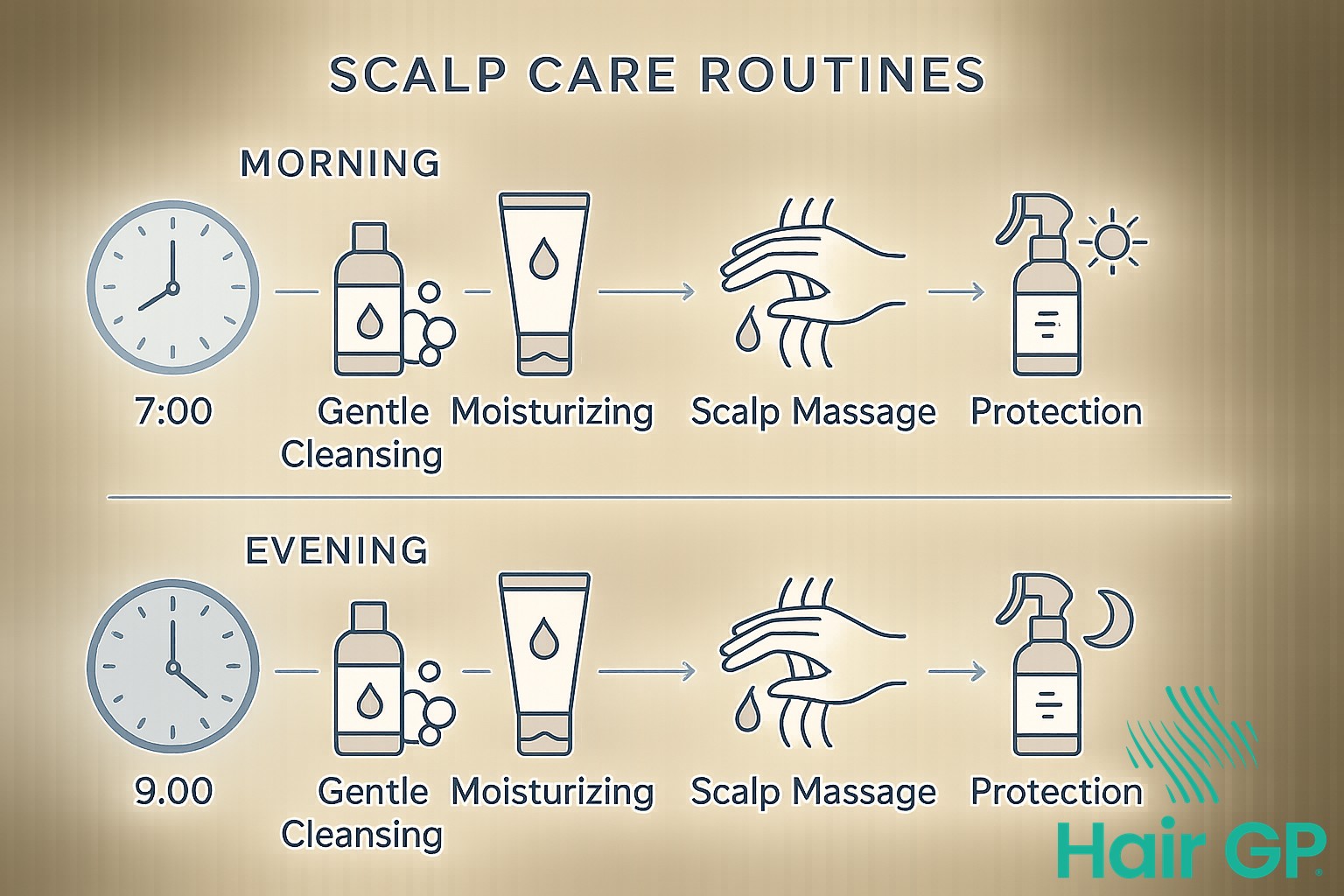
Natural and Home Remedies for Soothing Relief
Natural remedies offer gentle alternatives for managing chemotherapy-related scalp sensitivity using ingredients readily available at home. These evidence-based approaches can soothe irritated scalps whilst complementing medical treatments, providing comfort without harsh chemicals. Research indicates that certain natural ingredients possess anti-inflammatory properties beneficial for sensitive skin conditions[3].
Kitchen Cabinet Remedies
Common household items provide surprisingly effective scalp treatments for those seeking natural remedies. Oatmeal soaks offer exceptional relief through their anti-inflammatory compounds called avenanthramides. Create a soothing rinse by steeping finely ground oats in warm water for fifteen minutes, then straining before application.
Raw honey applications deliver antimicrobial benefits whilst maintaining scalp moisture. Mix two tablespoons of organic honey with warm water to create a gentle treatment that won’t irritate sensitive skin. Green tea rinses harness powerful antioxidants to calm inflammation—brew strong tea, cool completely, and use as a final rinse after washing to soothe tender scalps.
Herbal Solutions and Teas
Beneficial herbs provide centuries-old comfort for scalp care concerns. Chamomile’s natural anti-inflammatory properties make it ideal for reducing irritation and promoting healing. Steep chamomile flowers in hot water, cool, and apply as a compress or rinse to experience its calming effects.
Calendula, known for its wound-healing properties, offers gentle relief for sensitive scalps. Create an infusion using dried calendula petals steeped in warm water for twenty minutes. Lavender provides dual benefits—its aromatic properties promote relaxation whilst its compounds reduce inflammation and support skin healing naturally.
Safe Essential Oil Applications
Essential oils require careful handling, particularly for chemotherapy patients with heightened sensitivity. Proper dilution proves crucial—mix one drop of essential oil per tablespoon of carrier oil like jojoba or sweet almond[4]. Never apply undiluted oils directly to sensitive scalps.
Patch testing prevents adverse reactions. Apply diluted oil mixture to a small skin area twenty-four hours before full application. Watch for redness, itching, or irritation before proceeding with scalp treatments.
Application methods matter significantly. Gentle fingertip massage distributes oils whilst stimulating circulation. Add diluted oils to shampoo or create overnight treatments by applying before bed, covering with a soft cap. Tea tree, lavender, and chamomile oils prove particularly beneficial when properly diluted, offering antimicrobial and anti-inflammatory benefits that comfort irritated scalps.
Remember to consult healthcare providers before beginning any natural scalp care routine during cancer treatment. These gentle remedies complement medical care, providing additional comfort without interfering with prescribed treatments.
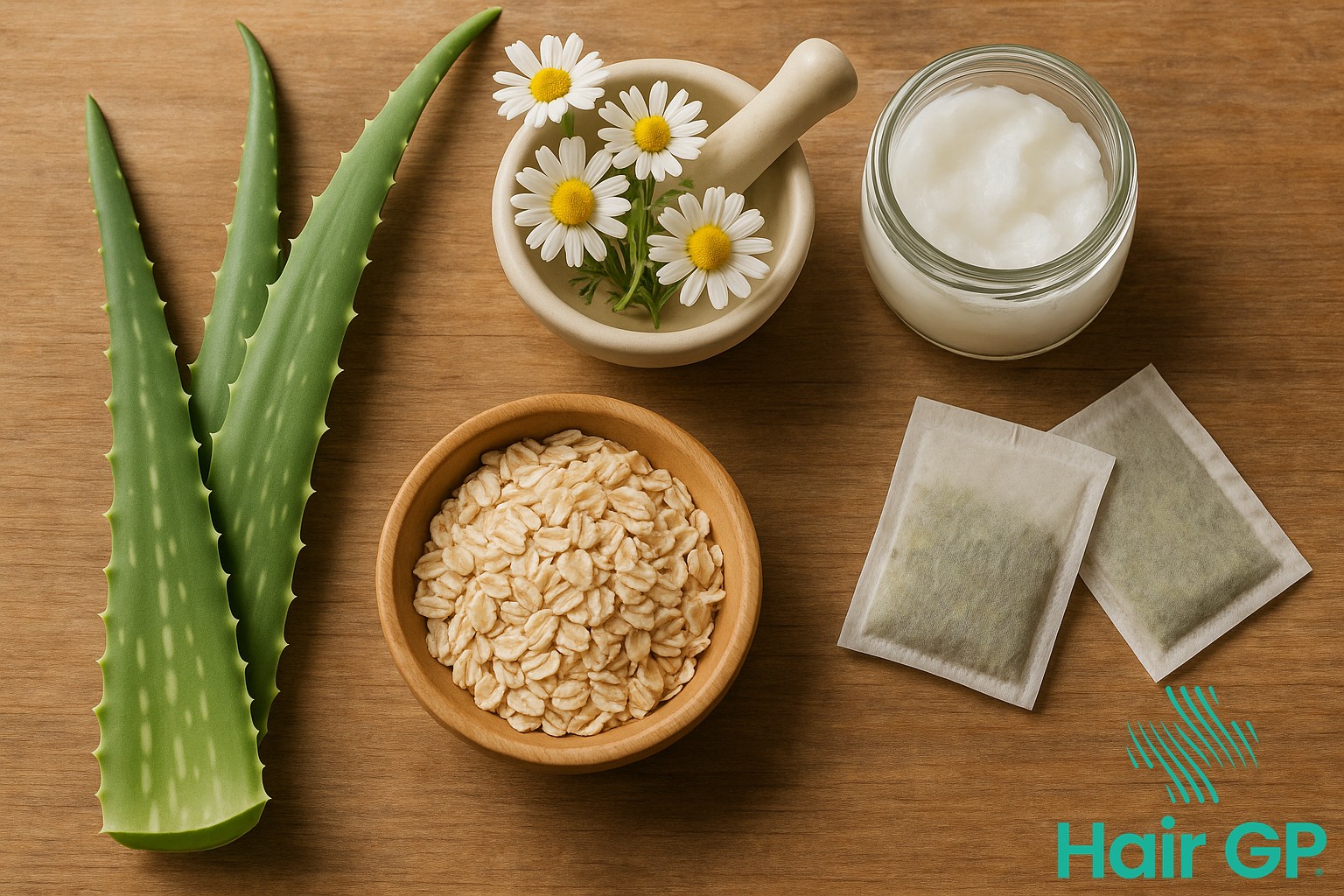
Product Guide: Shampoos, Conditioners, and Treatments
Selecting appropriate hair care products during chemotherapy requires careful consideration of ingredients and formulations designed for ultra-sensitive scalps. Understanding which components to seek and avoid helps ensure comfort whilst maintaining scalp health throughout treatment. This guide assists in navigating product choices tailored to your specific needs and budget.
Ingredients to Embrace
Beneficial ingredients for sensitive scalp care include gentle moisturising agents that nourish without overwhelming delicate skin. Seek products containing aloe vera, known for its soothing and anti-inflammatory properties. Chamomile extract offers calming benefits whilst reducing irritation. Natural oils like coconut, jojoba, and argan provide essential hydration without clogging pores. Glycerin acts as a humectant, drawing moisture to the scalp whilst maintaining balance. Look for pH-balanced formulas between 4.5 and 5.5, matching your scalp’s natural acidity. Mild shampoo formulations often feature plant-based cleansers like coco-glucoside or decyl glucoside, which clean effectively without stripping natural oils. Vitamin E provides antioxidant protection, whilst panthenol (vitamin B5) strengthens and conditions. Colloidal oatmeal soothes inflammation and provides relief from dryness or itching.
Ingredients to Avoid
Certain components can exacerbate scalp sensitivity during treatment, making avoidance crucial for comfort. Sulphates, including sodium lauryl sulphate and sodium laureth sulphate, strip natural oils and cause excessive dryness. Artificial fragrances, even those labelled ‘natural fragrance’, may trigger reactions on sensitive scalp tissue. Harsh preservatives like parabens and formaldehyde-releasing agents potentially irritate compromised skin barriers. Alcohol-based ingredients, particularly denatured alcohol or isopropyl alcohol, create drying effects. Avoid products containing retinoids, alpha-hydroxy acids, or salicylic acid, as these active ingredients prove too strong for chemotherapy-affected scalps. Essential oils, whilst natural, can cause reactions when skin sensitivity increases. Skip clarifying shampoos and anything labelled ‘deep cleansing’ as these formulations typically contain stronger detergents unsuitable for delicate scalp conditions.
Product Categories and Uses
Different hair care products serve specific purposes in maintaining scalp health during treatment. Cleansing products should focus on gentle formulas – choose cream-based or oil-based cleansers for extremely dry conditions. Co-washing products (cleansing conditioners) offer an alternative for those finding traditional shampoo too harsh. Deep conditioning treatments provide intensive moisture; apply weekly or as needed based on your hair and scalp type. Leave-in conditioners and scalp serums deliver continuous hydration throughout the day. Scalp oils and balms offer targeted relief for particularly dry or irritated areas.
Budget-Friendly vs. Premium Options
Quality sensitive scalp products exist across all price ranges, making care accessible regardless of budget. Drugstore options often provide excellent value, with many brands offering fragrance-free, hypoallergenic lines specifically formulated for sensitive skin. Professional salon lines typically feature concentrated formulas requiring less product per use, potentially offsetting higher initial costs. Consider purchasing smaller sizes initially to test compatibility with your scalp type before investing in full-sized products. Generic or store-brand versions of popular formulas frequently contain similar beneficial ingredients at reduced prices. Value considerations should include concentration levels, multi-use capabilities, and how products interact with your specific hair and scalp type.
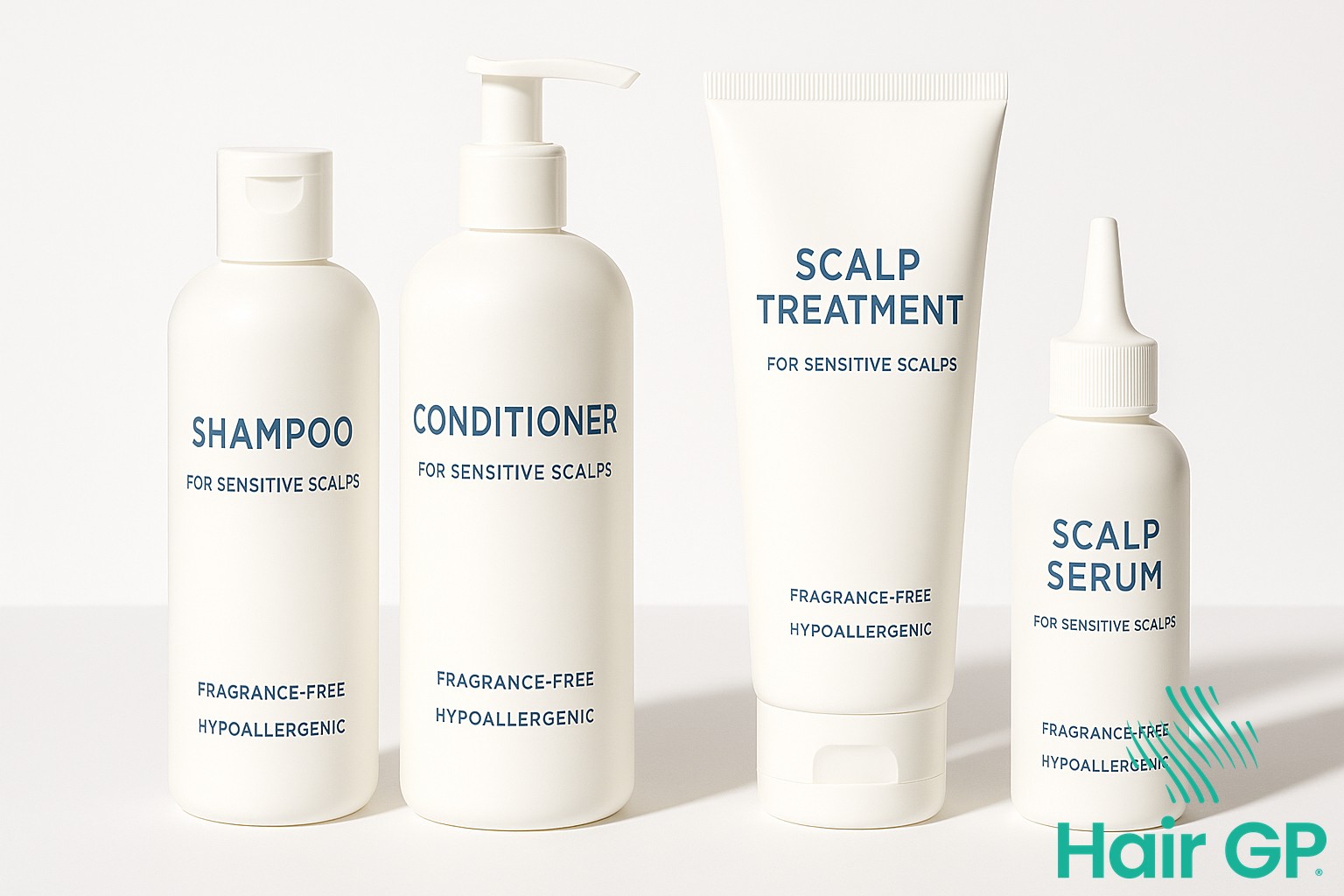
Managing Specific Scalp Symptoms and Conditions
Chemotherapy often triggers various scalp conditions requiring targeted management strategies. Understanding how to address specific symptoms helps maintain comfort throughout treatment whilst preventing more serious complications from developing.
Combating Persistent Itching
Scalp itching affects approximately 58% of chemotherapy patients, creating significant discomfort during treatment [5]. Cooling techniques provide immediate relief—apply cold compresses wrapped in soft cloth for ten-minute intervals. Store aloe vera gel in the refrigerator for enhanced cooling effects when applied to irritated areas.
Anti-itch treatments include calamine lotion and colloidal oatmeal solutions. Mix finely ground oats with cool water to create soothing paste applications. Distraction methods prove surprisingly effective: gentle scalp massage with fingertips, listening to calming music, or practising mindfulness meditation redirects attention from itching sensations. Avoid scratching, which damages delicate skin and increases infection risk.
Dealing with Dryness and Flaking
Dry scalp conditions manifest through tightness, visible flaking, and occasional peeling. Intensive moisturising requires heavier formulations than standard lotions. Apply thick, fragrance-free creams containing ceramides or hyaluronic acid twice daily, focusing on particularly dry areas. Leave-in treatments overnight maximise absorption—cover with silk scarves to protect bedding.
Gentle exfoliation removes dead skin accumulation without irritating sensitive scalps. Create mild scrubs using brown sugar mixed with olive oil, massaging gently in circular motions weekly. Hydration tips extend beyond topical treatments: increase water intake to eight glasses daily, use bedroom humidifiers maintaining 40-50% humidity levels, and avoid hot showers that strip natural oils. Flaky scalp responds well to consistent moisturising routines rather than aggressive treatments.
Managing Excess Oil Production
Paradoxically, some patients experience increased oily scalp during chemotherapy as sebaceous glands overcompensate for moisture loss. Gentle cleansing frequency matters—washing every other day with mild, sulphate-free shampoos prevents over-stimulating oil production. Rinse thoroughly with lukewarm water, ensuring no product residue remains.
Oil-absorbing treatments include dry shampoo applications between washes and clay masks weekly. Bentonite or kaolin clay mixed with water creates effective masks that draw excess sebum without harsh chemicals. Lifestyle factors influencing oil production include diet modifications—reduce fried foods and increase omega-3 fatty acids through fish or supplements.
Addressing Scalp Tenderness and Pain
Scalp tenderness ranges from mild sensitivity to significant pain requiring intervention. Cold therapy using gel packs wrapped in soft cloths provides numbing relief for fifteen-minute sessions. Alternate with room-temperature periods preventing tissue damage from prolonged cold exposure.
Gentle touch techniques involve minimal pressure when washing or styling. Use wide-toothed combs, avoiding tight hairstyles or accessories. Pain relief options include over-the-counter paracetamol following dosage guidelines. Topical lidocaine preparations offer localised numbness for severe discomfort—consult healthcare providers before use.
When Symptoms Require Medical Attention
Certain symptoms indicate complications requiring immediate medical evaluation. Infection signs include persistent redness, warmth, swelling, or yellow-green discharge from affected areas. Fever accompanying scalp symptoms suggests systemic involvement needing prompt treatment. Severe reactions manifesting as widespread rash, intense burning sensations, or blistering demand urgent assessment.
Persistent problems lasting beyond two weeks despite home treatments warrant professional evaluation. Seborrheic dermatitis or dandruff unresponsive to gentle care might require prescription medications. Document symptom patterns, treatments attempted, and responses to assist healthcare providers in determining appropriate interventions.
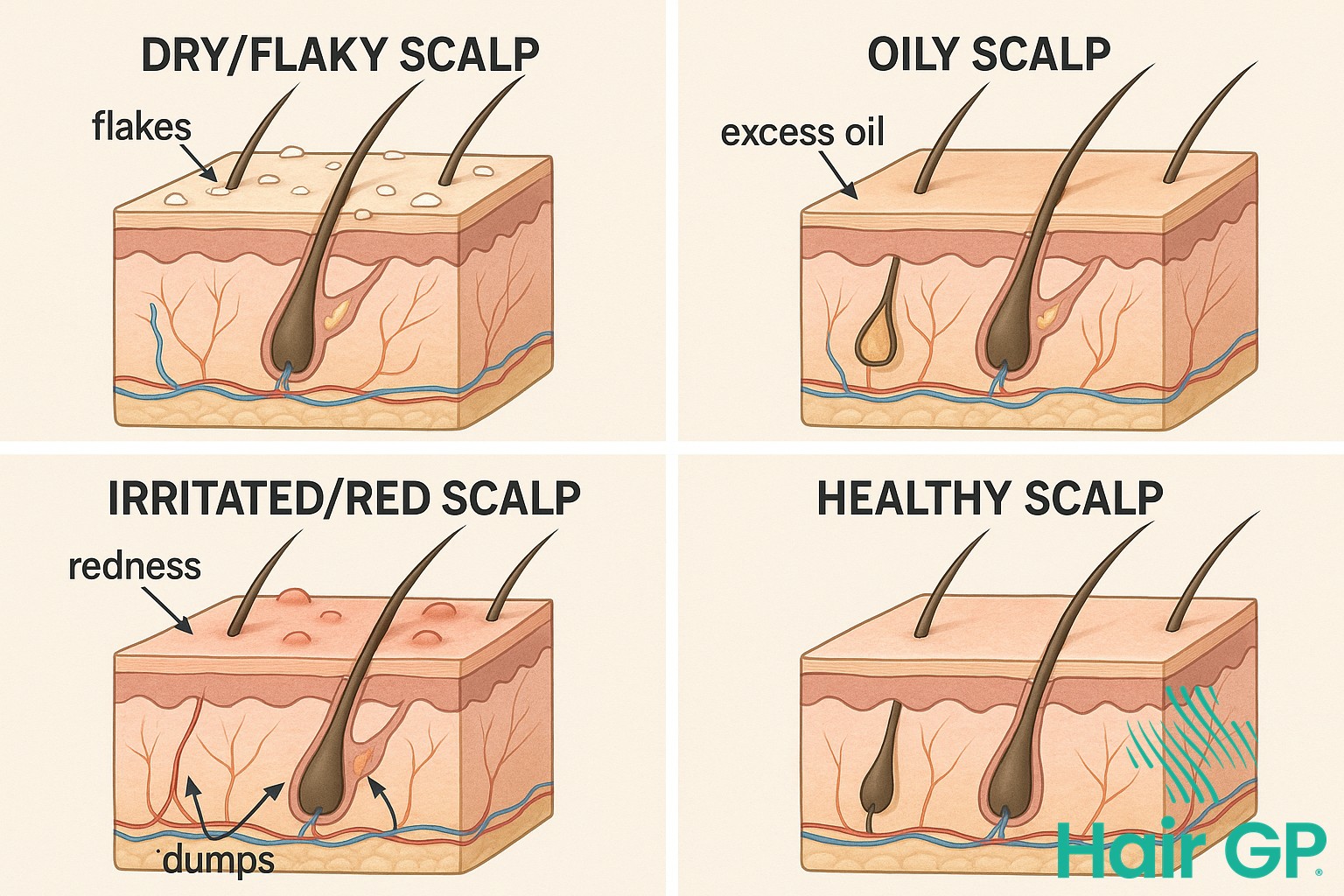
The Science and Benefits of Scalp Cooling
Scalp cooling therapy represents a significant advancement in preventing chemotherapy-induced hair loss for cancer patients. This innovative approach uses controlled cooling to protect hair follicles during chemotherapy treatment, offering patients the opportunity to maintain their hair and quality of life throughout their cancer journey.
How Scalp Cooling Works
The scientific mechanism behind scalp cooling involves multiple protective processes. When the scalp temperature drops to approximately 18-22°C, vasoconstriction occurs in the blood vessels supplying the hair follicles [6]. This narrowing of blood vessels significantly reduces blood flow to the scalp, limiting the amount of chemotherapy drugs that reach the hair follicles. Additionally, the cooling process slows cellular metabolism in the follicles, making them less susceptible to the cytotoxic effects of chemotherapy. The reduced drug uptake combined with decreased metabolic activity creates a protective environment that can prevent or minimise hair loss in many patients.
Candidates for Scalp Cooling
Not all cancer patients are suitable candidates for scalp cooling therapy. The treatment shows particular effectiveness for patients receiving chemotherapy for solid tumours, including breast, ovarian, and lung cancers. The FDA has cleared scalp cooling systems for use with specific chemotherapy regimens, particularly those containing taxanes and anthracyclines [7]. However, patients with haematological malignancies, such as leukaemia or lymphoma, are typically excluded due to theoretical concerns about protecting circulating cancer cells. Other contraindications include cold sensitivity, cold agglutinin disease, and cryoglobulinaemia. Healthcare providers assess each patient individually to determine suitability.
What to Expect During Treatment
Scalp cooling sessions begin approximately 30 minutes before chemotherapy infusion and continue throughout the treatment and for 90-120 minutes afterwards. Patients wear a specially designed cooling cap connected to a refrigeration unit. Initial discomfort from the cold typically subsides within 10-15 minutes as numbness develops. Common side effects include headaches, neck pain, and feeling cold, though most patients tolerate the procedure well. Success rates vary, with studies showing 50-65% of patients experiencing minimal hair loss. The commitment required for extended treatment sessions should be considered when making treatment decisions.
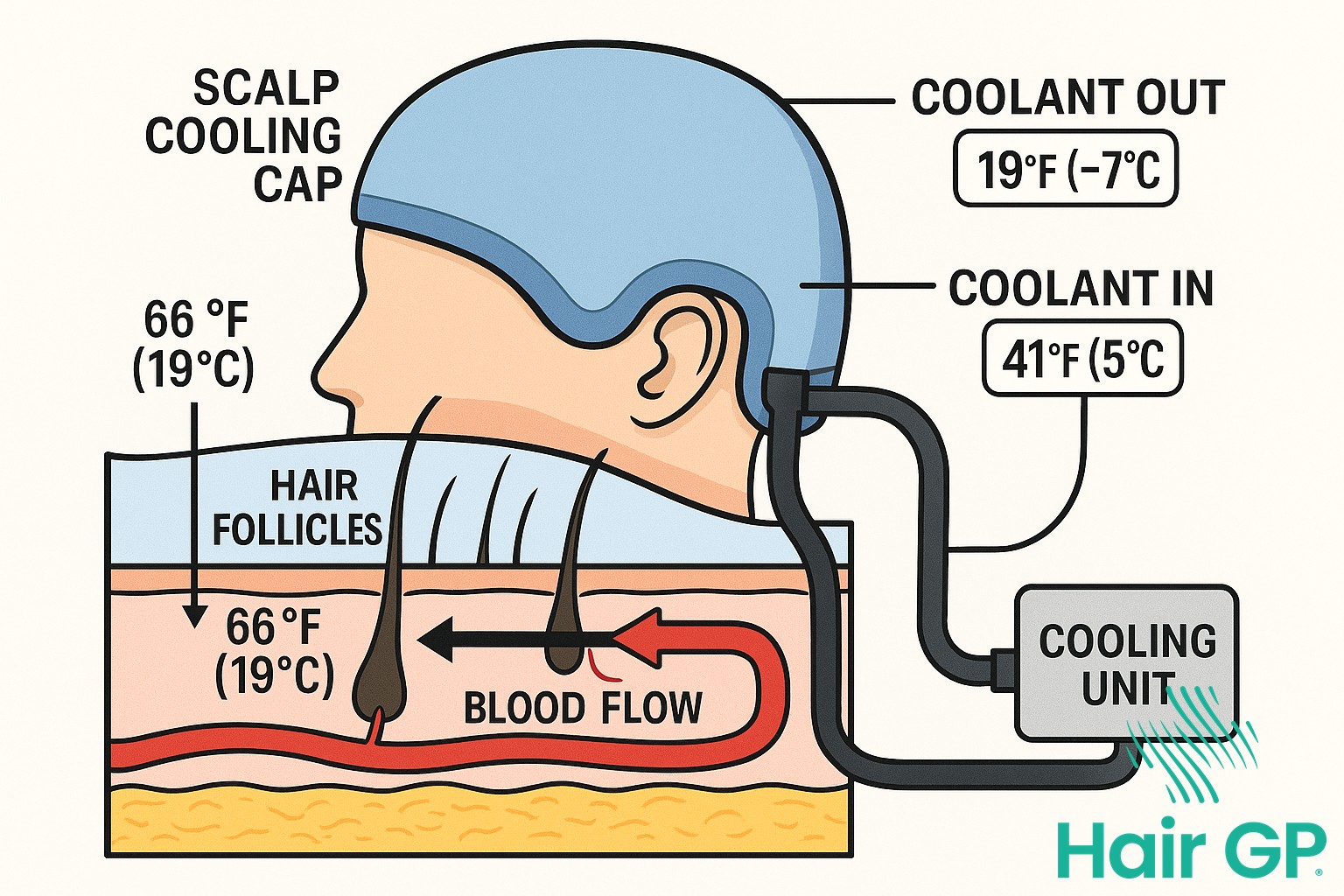
Nutrition and Supplements for Scalp Health
Proper nutrition plays a vital role in supporting scalp health and recovery during chemotherapy treatment. By focusing on nutrient-dense foods and carefully selected supplements under medical supervision, patients can create optimal conditions for healing and future healthy hair growth. A comprehensive approach combines essential nutrients, hydration, and targeted supplementation to support the scalp throughout the treatment journey.
Essential Nutrients for Scalp Recovery
Adequate protein intake forms the foundation of scalp health, as hair follicles require amino acids for cellular repair and regeneration. During chemotherapy, protein needs may increase to 1.2-1.5 grams per kilogram of body weight daily [8]. B-vitamins, particularly iron, folate, and B12, support cellular metabolism and tissue repair processes essential for scalp recovery. Zinc plays a crucial role in protein synthesis and wound healing, whilst iron supports oxygen delivery to scalp tissues. Deficiencies in these minerals can impair healing and delay hair regrowth post-treatment.
Scalp-Friendly Foods to Prioritise
Omega-3 fatty acids from salmon, mackerel, and walnuts provide anti-inflammatory benefits that support scalp healing. These essential fats help maintain cell membrane integrity and reduce inflammation-related discomfort. Antioxidant-rich options like berries, leafy greens, and colourful vegetables combat oxidative stress whilst providing vitamins A, C, and E for tissue repair. Hydrating foods including cucumbers, watermelon, and citrus fruits contribute to overall fluid intake whilst delivering vital nutrients. Whole grains provide steady energy and B-vitamins, supporting sustained nutrition throughout treatment.
Safe Supplementation During Treatment
Supplement use during chemotherapy requires careful medical supervision to avoid interactions with treatment protocols [9]. Vitamin D deficiency, common during cancer treatment, may benefit from supplementation to support immune function and tissue healing. However, high-dose antioxidant supplements can interfere with certain chemotherapy mechanisms. Always consult oncology teams before starting any supplements, as individual treatment plans vary significantly. Documentation of all supplements helps healthcare providers monitor potential interactions.
Hydration Strategies
Maintaining proper hydration supports scalp health by ensuring adequate blood flow and nutrient delivery to tissues. Aim for 8-10 glasses of water daily, adjusting for treatment side effects like nausea or increased fluid loss. Herbal teas, clear broths, and coconut water provide variety whilst contributing to hydration goals. Monitor hydration status through urine colour—pale yellow indicates adequate hydration. During chemotherapy sessions, increase fluid intake to help flush medications through the system and support overall healing processes.
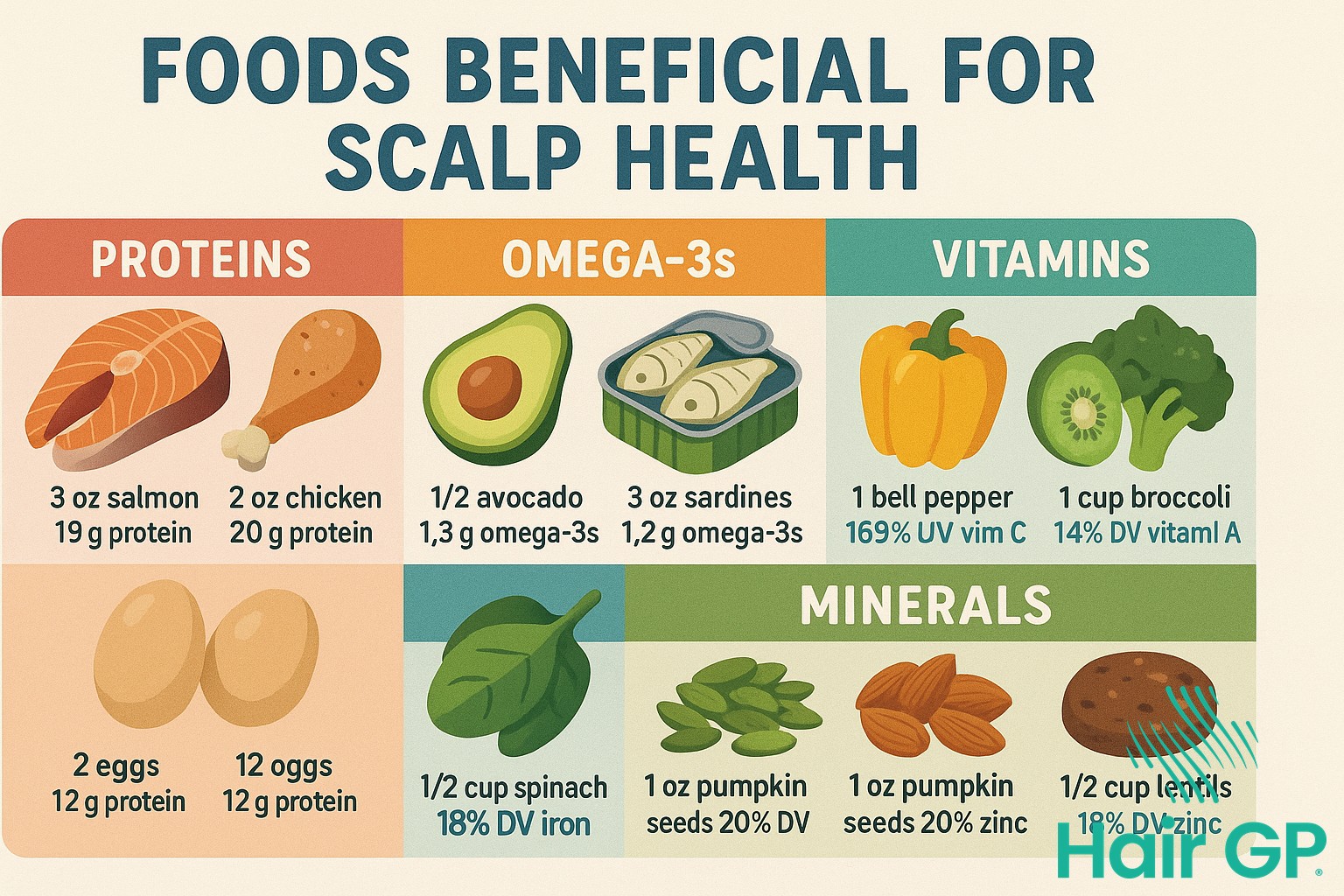
Supporting Hair Regrowth and Long-Term Recovery
The completion of chemotherapy marks the beginning of a new phase in your hair journey, one filled with hope for recovery and renewal. Understanding the hair regrowth process after treatment helps set realistic expectations whilst providing practical strategies to support healthy hair growth during this transitional period.
Understanding the Regrowth Timeline
Hair regrowth typically begins within three to six weeks after completing chemotherapy, though individual experiences vary considerably. Initial growth signs often appear as soft, downy hair similar to peach fuzz, which gradually transitions into stronger strands. Many patients notice texture changes during early regrowth, with hair potentially appearing curlier, straighter, or a different colour than before treatment. Complete hair regrowth usually takes six to twelve months, though achieving pre-treatment length and volume may require additional time. Understanding these phases helps manage expectations throughout the recovery process.
Caring for New Growth
Delicate new hair requires gentle handling to prevent breakage and encourage continued growth. Choose sulphate-free shampoos and lightweight conditioners specifically formulated for thinning hair or sensitive scalps. Avoid harsh chemical treatments, including perms and relaxers, for at least six months after regrowth begins. When styling, use wide-toothed combs and minimal heat, allowing hair to air dry whenever possible. Consider silk pillowcases to reduce friction whilst sleeping, protecting fragile new strands from unnecessary stress.
Stimulating Healthy Regrowth
Several safe methods can encourage healthy hair growth during recovery. Daily scalp massage for five to ten minutes increases blood circulation, potentially stimulating follicle activity. Natural circulation boosters include gentle exercise, staying hydrated, and maintaining a balanced diet rich in proteins, vitamins, and minerals. Some patients find success with rosemary oil diluted in a carrier oil, though always consult your oncologist before trying new treatments. Growth-supporting practices include stress reduction techniques, adequate sleep, and protecting the scalp from sun exposure.
Managing Expectations and Patience
The emotional aspects of hair regrowth require acknowledgement and patience. Timeline variations between individuals can cause anxiety, but remember that each person’s recovery follows its own schedule. Texture surprises, including unexpected curls or colour changes, often resolve within twelve to eighteen months. Celebrating milestones, such as the first trim or achieving ponytail length, helps maintain positive momentum throughout the journey. Document your progress with photos to appreciate gradual improvements that daily observation might miss.
Emotional Well-Being and Self-Care Strategies
The emotional impact of scalp sensitivity and hair changes during cancer treatment extends far beyond physical discomfort, affecting self-image, confidence, and psychological wellbeing. Addressing these challenges through a holistic approach that combines practical coping strategies, robust emotional support systems, and self-compassion practices enables cancer patients to navigate this difficult journey whilst maintaining their sense of identity and emotional equilibrium.
Coping with Physical Changes
The acceptance process for appearance changes requires time and patience, acknowledging that feelings of grief, frustration, or anxiety are entirely valid responses. Creative solutions such as experimenting with headscarves, wigs, or embracing baldness can transform a challenging experience into an opportunity for self-expression. Building confidence involves focusing on personal strengths beyond physical appearance, celebrating small victories, and recognising that beauty encompasses resilience and courage. Many breast cancer patients find that documenting their journey through photography or journaling helps process emotions whilst creating a powerful narrative of strength.
Building a Support Network
Establishing meaningful connections with others experiencing similar challenges provides invaluable emotional support and practical advice. Local support groups offer face-to-face interaction and shared experiences, whilst online communities provide 24/7 access to understanding voices worldwide. Professional counselling services specialising in cancer-related concerns offer structured support for processing complex emotions. Family and friends can provide comfort through simple gestures like accompanying patients to appointments or helping explore self-care options that accommodate scalp sensitivity.
Self-Compassion Practices
Mindfulness techniques, including gentle meditation and breathing exercises, help manage anxiety whilst promoting present-moment awareness rather than future worries. Positive affirmations tailored to individual experiences reinforce inner strength and resilience. Stress reduction through gentle activities like nature walks, creative pursuits, or listening to calming music supports overall wellbeing. Regular self-care rituals, whether applying soothing scalp treatments or enjoying favourite comfort foods, remind patients to prioritise their emotional needs alongside physical healing.
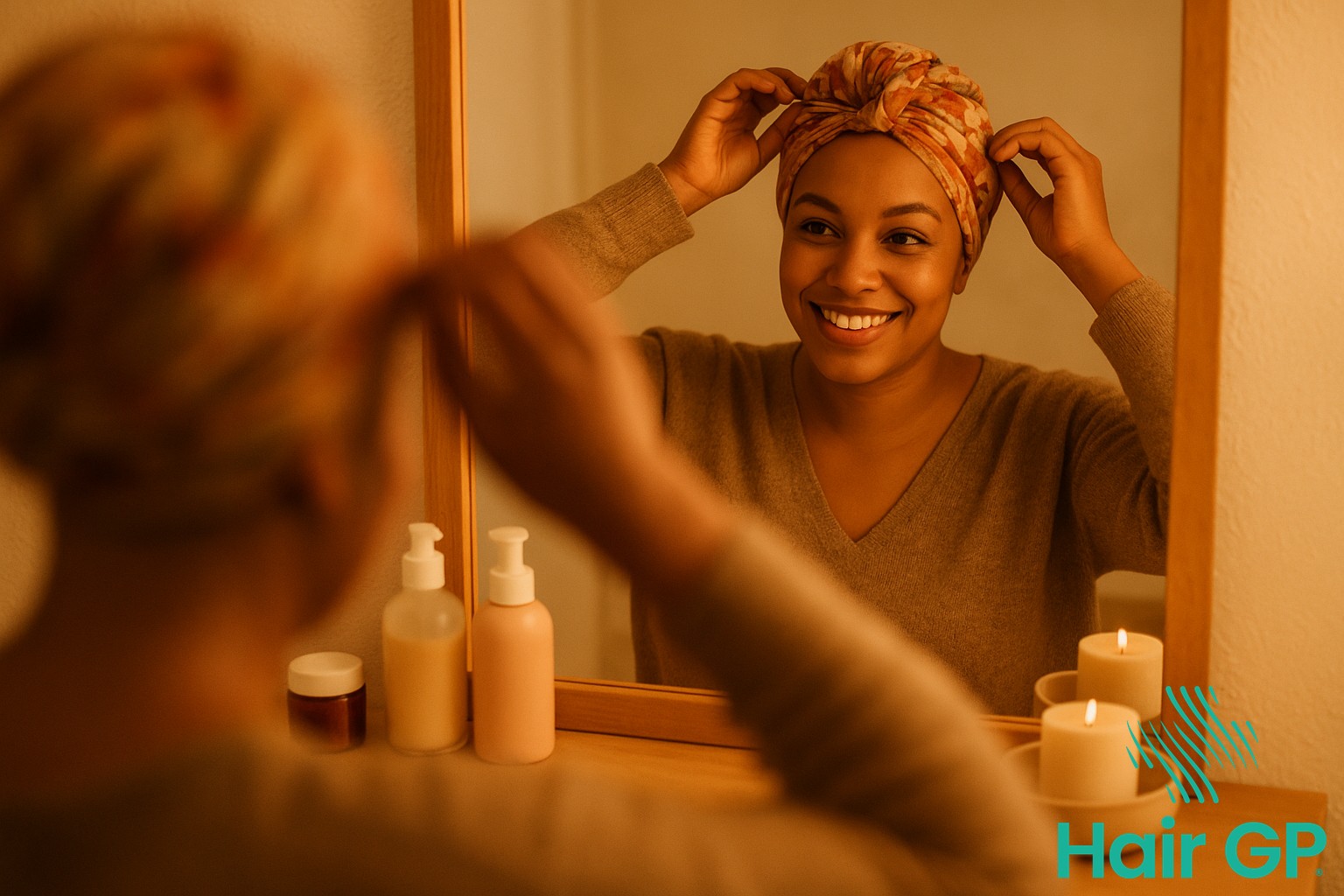
Conclusion
Scalp sensitivity following chemotherapy is a common experience for chemotherapy patients, but understanding that this discomfort is temporary can provide reassurance during the recovery process. The journey towards healing requires patience, gentle care, and consistent attention to your scalp’s changing needs. By implementing the strategies discussed—from choosing fragrance-free products to maintaining proper hydration and nutrition—you can significantly improve your comfort levels whilst supporting natural hair growth.
Remember that each person’s healing journey is unique, and what works for one individual may require adjustment for another. The key lies in listening to your body, being patient with the recovery timeline, and maintaining gentle care routines that nurture your sensitive scalp. As your scalp heals and new hair begins to emerge, the sensitivity will gradually diminish.
Whilst managing scalp sensitivity can feel overwhelming initially, know that with proper care and time, this phase will pass. Many chemotherapy patients successfully navigate this challenge and experience complete recovery. Stay committed to your gentle care routine, celebrate small improvements, and trust in your body’s remarkable ability to heal. Your dedication to proper scalp care today lays the foundation for healthier hair growth tomorrow.
Frequently Asked Questions
Scalp sensitivity typically begins to improve within 4-6 weeks after completing chemotherapy, though complete resolution can take 3-6 months. The timeline varies based on the specific drugs used, treatment duration, and individual healing rates. Most patients report significant improvement by the three-month mark.
It’s best to avoid chemical hair treatments like coloring, perming, or relaxing until your scalp has fully healed and new hair growth is well-established, typically 6-12 months post-treatment. When you do resume these treatments, opt for gentler, ammonia-free products and always perform a patch test first.
Yes, burning, tingling, or prickling sensations are common during and after chemotherapy. These sensations result from nerve endings being affected by treatment. While uncomfortable, they’re usually temporary. However, severe pain, blistering, or signs of infection should be reported to your healthcare team immediately.
Sleep on your back when possible to minimize pressure on your scalp. Use a silk or bamboo pillowcase to reduce friction, and consider a memory foam pillow that contours to your head without creating pressure points. Some patients find relief by slightly elevating their head to reduce scalp blood flow and sensitivity.
Gentle scalp massage can improve circulation and provide comfort, but it should be extremely light during peak sensitivity. Use only fingertips with minimal pressure for 2-3 minutes daily. As sensitivity decreases, you can gradually increase pressure. Scalp massage may support hair regrowth by improving blood flow to follicles.
References
- Freites-Martinez A, Shapiro J, Goldfarb S, et al. Hair disorders in patients with cancer. J Am Acad Dermatol. 2019;80(5):1179-1196.
- Paus R, Haslam IS, Sharov AA, Botchkarev VA. Pathobiology of chemotherapy-induced hair loss. Lancet Oncol. 2013;14(2):e50-59.
- Reynertson KA, Garay M, Nebus J, et al. Anti-inflammatory activities of colloidal oatmeal (Avena sativa) contribute to the effectiveness of oats in treatment of itch associated with dry, irritated skin. J Drugs Dermatol. 2015;14(1):43-48.
- Ramsey JT, Shropshire BC, Nagy TR, et al. Essential Oils and Health. Yale J Biol Med. 2020;93(2):291-305.
- Freites-Martinez A, Shapiro J, Goldfarb S, et al. Hair disorders in patients with cancer. J Am Acad Dermatol. 2019;80(5):1179-1196.
- Rugo HS, Klein P, Melin SA, et al. Association Between Use of a Scalp Cooling Device and Alopecia After Chemotherapy for Breast Cancer. JAMA. 2017;317(6):606-614.
- Nangia J, Wang T, Osborne C, et al. Effect of a Scalp Cooling Device on Alopecia in Women Undergoing Chemotherapy for Breast Cancer: The SCALP Randomized Clinical Trial. JAMA. 2017;317(6):596-605.
- Muscaritoli M, Arends J, Bachmann P, et al. ESPEN practical guideline: Clinical Nutrition in cancer. Clin Nutr. 2021;40(5):2898-2913.
- Ambrosone CB, Zirpoli GR, Hutson AD, et al. Dietary Supplement Use During Chemotherapy and Survival Outcomes of Patients With Breast Cancer Enrolled in a Cooperative Group Clinical Trial (SWOG S0221). J Clin Oncol. 2020;38(8):804-814.

